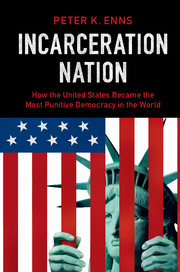4 - Explaining the public's punitiveness
Published online by Cambridge University Press: 05 March 2016
Summary
“Crime up 15% Here Last Year,” Washington Post headline, January 11, 1964
“Crime Rate Rises 10% Here in Year, Increase Equal to Nation's,” New York Times headline, January 29, 1964
In early 1964, news of rising crime rates echoed throughout the nation. In addition to the articles cited above, the Washington Post and the New York Times announced rising crime rates with headlines like “Serious Crime in January up 34% over Same Month Last Year,” “Serious Crime up 29% in Montgomery County,” “New Patrol to Fight Rising Crime Rate,” and “F.B.I. Reports a 10% Rise in Serious Crime in 1963.” Similar stories played out in sunny California and the unusually temperate Chicago. Headlines in the Los Angeles Times informed readers that “Glendale Police Report Crimes in City Exceeded 2,000 during 1963” and “Juvenile Crime up 12%.” The Chicago Tribune proclaimed, “Major Crime Rises Sharply in Milwaukee” and “Crime Soars; Blame Weather: Wilson Cites Lack of Snow during Balmy January.” Regardless of where one lived, news was highlighting increasing criminal activity.
This chapter shows that throughout the past sixty years, news reports like these have drawn attention to shifting crime rates and have shaped the public's punitiveness in fundamental ways. The argument that the news media follow the crime rate and that these news reports influence the public's support for being tough on crime may sound intuitive. Indeed, some evidence suggests the public became more punitive as crime increased during the 1960s and 1970s (Mayer 1992, Niemi, Mueller, and Smith 1989). Yet this argument does not represent the prevailing scholarly view. Summarizing the dominant perspective on the topic, Michelle Alexander (2010, p. 54) explains, “The level of public concern about crime and drugs was only weakly correlated with actual crime rates, but highly correlated with political initiatives, campaigns, and partisan appeals.” Thus, the connection this chapter draws between crime, news, and public opinion offers a crucial new understanding of the development of punitive attitudes in the United States. This chapter also builds on the findings in Chapter 3, offering further evidence that political elites were more likely to follow, not lead, the public's shifting preferences.
In order to identify the relationships between crime, news coverage of crime, and the public's punitiveness, this chapter begins by documenting how crime rates have increased and decreased across the country since the 1950s.
- Type
- Chapter
- Information
- Incarceration NationHow the United States Became the Most Punitive Democracy in the World, pp. 74 - 99Publisher: Cambridge University PressPrint publication year: 2016
- 2
- Cited by



